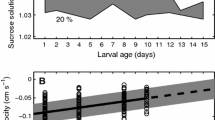Abstract
The snail Cerithium moniliferum Kiener at Heron Island (southern end of the Great Barrier Reef) clusters at outgoing tide and disperses at incoming tide. In containers with a constant water level, but exposed to the normal day and night rhythm, the snails cluster and disperse rhythmically for up to several days. Graphical simulation and spectral analysis, preceded by first difference filtering, showed two components, one corresponding to the tidal, and the other to the diurnal rhythm. Snails kept under continuous light also exhibit a two-component rhythm of clustering and dispersal. In containers with high (40 cm) water level and under continuous light or normal day and night rhythm, the two-component rhythm may—for some unknown reason—be replaced by long fluctuations of dispersal, with clustering occurring in the afternoon only in snails kept under normal alternation of day and night. Snails kept for 24 h in dryness prior to putting them into containers with water, remain clustered (sometimes with an initial dispersal “shock”) for a long time, with subsequent slow fluctuations of clustering and dispersal, probably induced by the light conditions. Factors contributing to clustering and dispersal are: (1) increased rate of dropping from container walls at outgoing tide; (2) lack of locomotory activity at low tide; (3) negative geotaxis at incoming tide; (4) positive geotaxis at outgoing tide; (5) attraction of snails by other snails (positive chemotaxis) throughout the rhythm. Sudden exposure to light increases the rate of dropping from the container walls and may be a contributing factor to stronger clustering during the day. Factors 1–4 show endogenous periodicities.
Similar content being viewed by others
Literature Cited
Bünning, E.: The physiological clock, 3rd. ed. 258 pp. Berlin, Göttingen, Heidelberg: Springer-Verlag 1973
Jenkins, G.M. and D.G. Watts: Spectral analysis and its applications. Holden Day Series in Time-Series Analysis, 525 pp. San Francisco, Cambridge, London, Amsterdam: Holden-Day Publ. 1968
Moulton, J.M.: Intertidal clustering of an Australian gastropod. Biol. Bull. mar. biol. Lab., Woods Hole 123, 170–178 (1962)
Author information
Authors and Affiliations
Additional information
Communicated by G. Humphrey, Sydney
Publication from the Heron Island Research Station.
Rights and permissions
About this article
Cite this article
Rohde, K., Sandland, R. Factors influencing clustering in the intertidal snail Cerithium moniliferum . Marine Biology 30, 203–215 (1975). https://doi.org/10.1007/BF00390743
Accepted:
Issue Date:
DOI: https://doi.org/10.1007/BF00390743




